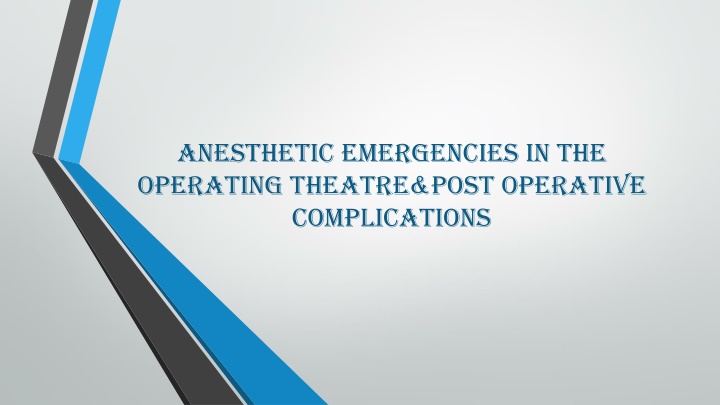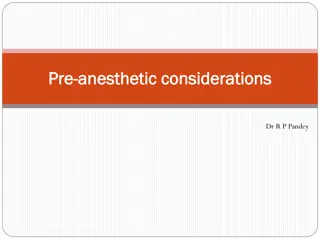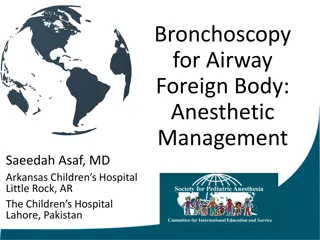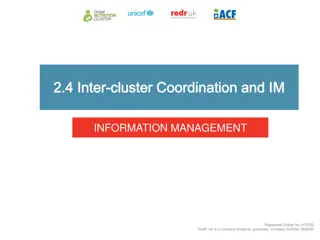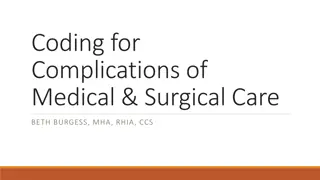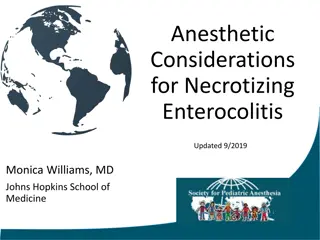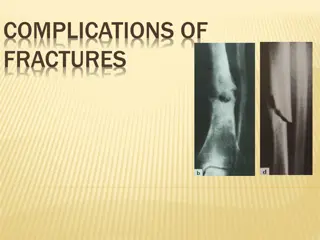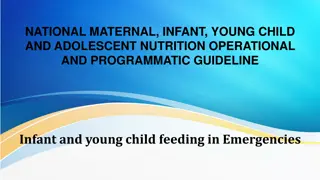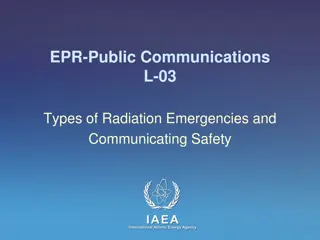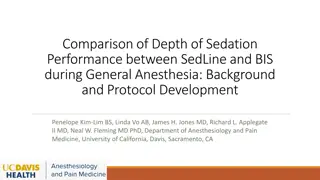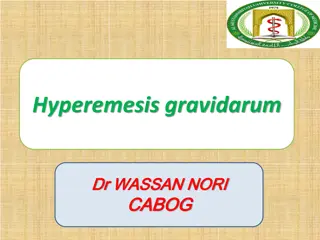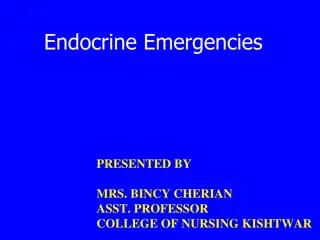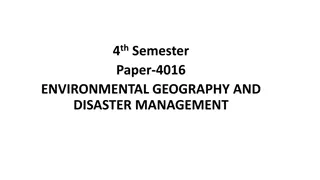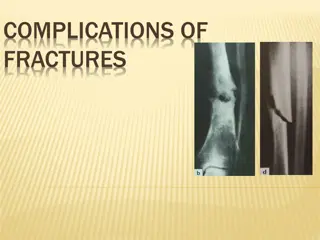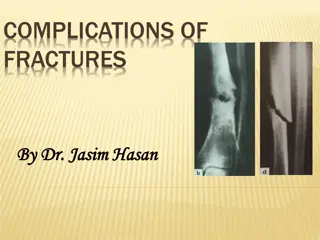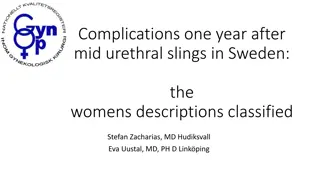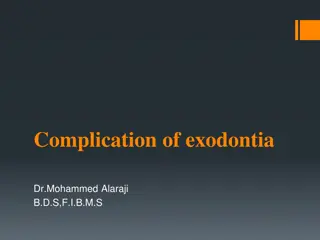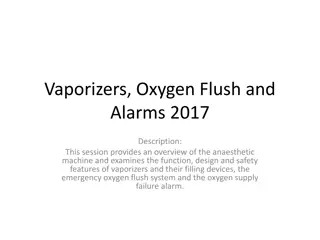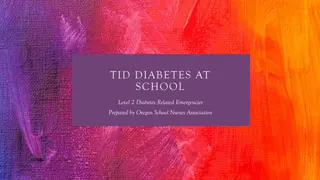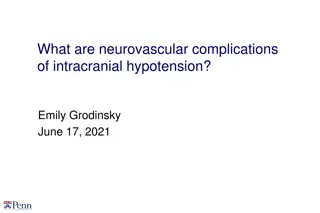Anesthetic Emergencies: Approaches and Complications
Emergencies in the operating theatre can be life-threatening, requiring immediate action. Learn about common anesthetic emergencies, post-operative complications, and management strategies including respiratory, hemodynamic problems, PONV, agitation, delirium, delayed emergence, and pain management.
Download Presentation

Please find below an Image/Link to download the presentation.
The content on the website is provided AS IS for your information and personal use only. It may not be sold, licensed, or shared on other websites without obtaining consent from the author.If you encounter any issues during the download, it is possible that the publisher has removed the file from their server.
You are allowed to download the files provided on this website for personal or commercial use, subject to the condition that they are used lawfully. All files are the property of their respective owners.
The content on the website is provided AS IS for your information and personal use only. It may not be sold, licensed, or shared on other websites without obtaining consent from the author.
E N D
Presentation Transcript
Anesthetic emergencies in the operating theatre&post operative complications
Lecture Objectives.. Students at the end of the lecture will be able to: 1. Learn a common approach to emergency medical problems encountered in intraoperative and postoperative period. 2. Study post-operative respiratory and hemodynamic problems and understand how to manage these problems. 3. Learn about the predisposing factors, differential diagnosis and management of PONV. 4. Understand the causes and treatments of post-operative agitation and delirium. 5. Learn about the causes of delayed emergence and know how to deal with this problem. 6. Learn about different approaches of post-Operative pain management
Anesthetic emergencies in the operating theatre Introduction Emergencies are not common but when they do occur they are often life threatening and require immediate action. Factors in the mnemonic COVER ABCD accounts for approximately 95% of critical incidents.
Color saturation, central cyanosis; Oxygen ensure adequate and correct delivery; Ventilation e.g. breathing circuit, air entry, CO2 trace, vaporizer; Endotracheal tube kinks, obstruction, endobronchial; Review monitors correctly sited, checked, calibrated; Airway failed intubation, laryngeal spasm, foreign body, aspiration; Breathing difficult to ventilate, e.g. tube occlusion, bronchospasm, pneumothorax, aspiration, lack of neuromuscular blocking drug (NMBD), pulmonary edema; Circulation hypotension: excess anesthetic agent, dysrhythmia, myocardial ischemia/MI, hypovolemia from any cause (e.g. dehydration, bleeding), sepsis, tension pneumothorax, sympathetic block (e.g. spinal or epidural anesthetic); Drugs anaphylaxis, wrong drug/dose/route; Embolism air/fat/cement/amniotic fluid; Others related to CVP line (pneumothorax [see Chapter 25]/cardiac tamponade); awareness; endocrine and metabolic (MH, pheochromocytoma).
Aspiration Definition:- inhalation of gastric contents can occur in patients who do not have fully functional upper airway reflexes. Signs Gastric contents visible within breathing circuit/airway adjunct (e.g. LMA) SaO2 Wheeze/stridor Tachycardia Airway pressure
Regurgitation of gastric contents can happen in any patient who does not have fully functioning upper airway protective reflexes. Those at risk include: Inadequate period of preoperative starvation Delayed gastric emptying (e.g. opiates, pain, bowel obstruction, pregnancy at term. Insufficient/lack of cricoid pressure at induction of anesthesia early extubation in an at-risk patient in supine position .
Treatment 100% oxygen Call for help 30% Head-down position to prevent/limit aspiration Oropharyngeal suction Tracheal intubation if needed, including tracheal suctioning Postoperatively: physiotherapy, oxygen. Some advocate antibiotics and steroids
Air embolism Definition:- air embolism results from inadvertent introduction of air into the circulation, usually via the venous system. Causes: Neurosurgery (dural sinuses are non-collapsible) Caesarean section (e.g. if exposed veins are raised above level of heart) Central line insertion/removal Epidural catheter placement (if loss of resistance to air is used) Entrainment through an intravenous line (especially if pressure-assisted) Situations where high pressure gas is used (laparoscopy)
Signs: HR BP SaO2 ETCO2 (acute due to ventilation perfusion mismatch) Murmur (millwheel,due to air circulating around the cardiac champers )
Treatment: 100% Oxygen Airway, breathing, circulation and call for help Flood surgical site with saline Position patient in Trendelenburg/left lateral decubitus position Consider inserting a central venous catheter to aspirate gas Consider hyperbaric chamber if indicated.
Laryngospasm Definition:- is the complete or partial adduction of the vocal cords, resulting in a variable degree of airway obstruction. Causes: Airway manipulation Blood/secretions in oropharynx Patient movement Surgical stimulus Failure to deliver anesthetic agent
Signs Partial/complete airway obstruction Paradoxical respiratory effort in a spontaneously breathing patient (abdominal/ chest see-saw movements as respiratory effort attempts to overcome the obstruction).
Treatment Some or all might be needed: Positive pressure ventilation with high flow oxygen (e.g. CPAP or IPPV) Deepening of anesthesia (e.g. i.v. propofol) Suxamethonium with or without tracheal intubation causes rapid muscle relaxation and ceases vocal cord opposition .
Complications SaO2 Aspiration Bradycardia (especially in children) Pulmonary edema
Failed intubation (reproduced from the Difficult Airway Society, with permission) 1. Assess the likelihood and clinical impact of basic management problems: Difficulty with patient cooperation or consent Difficult mask ventilation Difficult supraglottic airway placement Difficult laryngoscopy Difficult intubation Difficult surgical airway access
Failed intubation (reproduced from the Difficult Airway Society, with permission) Direct laryngoscopy Any problems Call for help
2. Actively pursue opportunities to deliver supplemental oxygen throughout the process of difficult airway management. 3. Consider the relative merits and feasibility of basic management choices: Awake intubation vs. intubation after induction of general anesthesia Non-invasive technique vs. invasive techniques for the initial approach to intubation Video-assisted laryngoscopy as an initial approach to intubation Preservation vs. ablation of spontaneous ventilation
Plan A: Initial tracheal intubation plan Initial tracheal intubation plan Direct laryngoscopy check: neck flexion and head extension Laryngoscope technique and vector External laryngeal manipulation by laryngoscopist Vocal cords open and immobile If poor view: Introducer (bougie) seek clicks or hold-up and/or alternative laryngoscope
Plan B Secondary tracheal intubation plan ILMA or LMA Not more than 2 insertions Oxygenate and ventilate Failed oxygenation (e.g. SpO2 < 90% with FiO2 1.0) via ILMATM or LMATM
Plan C Maintenance of oxygenation, ventilation, postponement of surgery and awakening Revert to face mask Oxygenate and ventilate Reverse non-depolarising relaxant 1 or 2 persons mask technique (with oral nasal airway)
Plan D Rescue techniques for can't intubate, can't ventilate situation
Malignant hyperthermia Definition:- this occurs after exposure to a triggering agent (volatile anaesthetics or suxamethonium) and results in loss of normal calcium homeostasis within skeletal muscle cells.
Anaphylaxis Definition:- this is an acute severe type 1 hypersensitivity reaction when an antigen (trigger) reacts with immunoglobulin IgE bound to histamine rich mast cells and basophils. Symptoms Signs Anxiety, feeling of impending doom Angioedema, e.g. skin, lips, throat Rash, itch Rash, flushing, urticaria Wheeze, shortness of breath Tachycardia, bradycardia, dysrhythmias Abdominal pain, diarrhea, vomiting Hypotension Chest pain Bronchospasm
Treatment Basic resuscitation based on Airway Breathing Circulation (ABC) Secondary treatment Remove suspected cause Chlorpheniramine 10mg (H1 antagonist) Call for help Hydrocortisone 200mg Give patient 100% oxygen, tracheal intubation if necessary Consider alternative vasopressor if unresponsive to epinephrine Elevate legs if hypotension (increases venous return) Consider salbutamol i.v. /nebulizer, aminophylline, for persistent Start cardiopulmonary resuscitation (CPR) if needed Give epinephrine 50 g in repeated doses; consider epinephrine infusion bronchospasm High dependency or intensive care transfer Give large volumes of fluid, e.g. normal saline or Hartmann s solution
Cardiac arrest Advanced life support algorithm
During CPR Ensure high-quality CPR rate, depth, recoil Reversible causes Plan actions before interrupting CPR Hypoxia Give oxygen Hypovolemia Consider advanced airway and capnography Hypo-/hyperkalemia/metabolic Hypothermia Continuous chest compressions when advanced airway in place Thrombosis coronary or pulmonary Tamponade cardiac Vascular access (intravenous, intraosseous) Toxins Give adrenaline every 3 5 min Tension pneumothorax Correct reversible causes
Status asthmaticus This is a severe acute exacerbation of asthma refractory to conventional 2 agonist therapy and is a medical emergency. Signs:- give supplemental oxygen to maintain SaO294 98%; Treatment tachypnea; 2 agonist (either salbutamol or terbutaline) via O2 driven nebulizer; use of accessory respiratory muscles (e.g. abdominal, sternocleidomastoid), and intercostal and subcostal recession; continuous nebulization can be used if there is a poor initial response; wheeze might be minimal or absent; tachycardia; intravenous 2 agonists should only be used when the inhaled route is unreliable; pulsus paradoxus >10 mmHg (a reduction in blood pressure on inspiration); steroids either oral prednisolone or i.v. hydrocortisone; sweating; nebulized ipratropium (anticholinergic); tiring; consider i.v. magnesium sulphate when life-threatening or poor initial response to treatment; aminophylline might also be considered in this situation. confusion.
Post Anesthesia Care Unit (PACU) The role of the anesthetist is not limited to theatres. There may be a number of postoperative responsibilities to undertake, both in the recovery room and on the surgical ward. After receiving anesthesia for a surgery or procedure a patient is sent to the PACU to recover and wake up . The PACU is a critical care unit where the patient s vital signs are closely observed ,pain management begins , and fluids are given . The nursing staff is skilled in recognizing and managing problems in patients after receiving anesthesia . The PACU is under the direction of the Department of Anesthesiology.
PACU Design should match function Location: Close to the OR. Access to x-ray, blood bank & clinical labs. Monitoring equipment Emergency equipment Personnel
Admission to PACU Steps: Coordinate prior to arrival, Assess airway, Administer oxygen, Apply monitors, Obtain vital signs, Receive report from anesthesia personnel.
PACU - ASA Standards 1. Standard I All patients should receive appropriate care 2. Standard II All patients will be accompanied by one of anesthesia team 3. Standard III The patient will be reevaluated & report given to the nurse 4. Standard IV The patient shall be continually monitored in the PACU 5. Standard V A physician will signing for the patient out of the PACU
Patient Care in the PACU Admission Apply oxygen and monitor Receive report Monitor & Observe & Manage To Achieve Cardiovascular stability Respiratory stability Pain control Discharge from PACU
Monitoring in the PACU Baseline vital signs. Respiration RR/min, Rhythm Pulse oximetry Circulation PR/min & Blood pressure ECG Level of consciousness Pain scores
Initial Assessment 1. Color 2. Respiration 3. Circulation 4. Consciousness 5. Activity
Aldrete Score Activity Respiration Circulation Oxygen Saturation Score Consciousness Breaths deeply and coughs BP + 20 mm of preanesth. level Moves all extremities Fully awake Spo2 > 92% on room air 2 freely. Dyspneic, or shallow breathing BP + 20-50 mm of preanesth. level Spo2 >90% With suppl. O2 Moves 2 extremities Arousable on calling 1 BP + 50 mm of preanesth. level Spo2 <92% With suppl. O2 Unable to move Apneic Not responding 0
Common PACU Problems Airway obstruction Hypoxemia Hypoventilation Hypotension Hypertension Cardiac dysrhythmias Hypothermia Bleeding Agitation Delayed recovery PONV Pain Oliguria
1. Airway Obstruction Most common: tongue fall back posterior pharynx May be foreign body Inadequate relaxant reversal Residual anesthesia
Management of Airway Obstruction Patient s stimulation, Suction, Oral Airway, Nasal Airway, Others: Tracheal intubation Cricothyroidotomy Tracheotomy
2. Hypoventilation Residual anesthesia Narcotics Inhalation agent Muscle Relaxant Post oper - Analgesia Intravenous Epidural
Treatment of Hypoventilation Close observation, Assess the problem, Treatment of the cause: Reverse (or Antidote): Muscle relaxant Neostigmine Opioids Naloxone Midazolam Anexate
